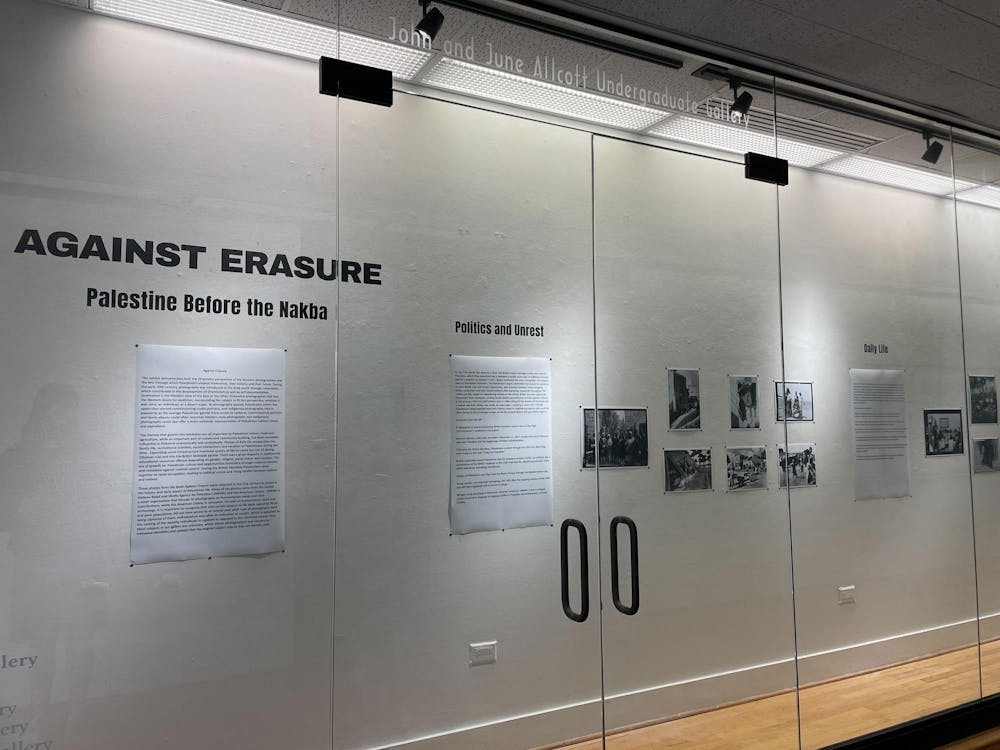A picture can say a thousand words. This common adage is echoed in "Against Erasure," a photo exhibit unveiled on Nov. 6 at the Hanes Art Center, which aims to depict the daily lives of Palestinian people in the early 20th century. The exhibit was unveiled as part of a grander exhibition of art projects related to Palestine.
The collection includes a mural created during and shortly after UNC Students for Justice in Palestine's Gaza Solidarity Encampment in April, a narrative painting "When Olive Trees Weep" created by UNC students and an installation of the People’s University, a project built in Polk Place to commemorate one year of the genocide and scholasticide in the Gaza Strip.
The wall installation on the ground floor of Hanes Art Center was created and installed by the students of Dr. Nadia Yaqub, a professor in the department of Asian and Middle Eastern Studies at UNC. The installation depicts the history and daily aspects of Palestinian life using photos taken from the book "Against Erasure: A Photographic Memory of Palestine Before the Nakba," from which the installation receives its name.
"Against Erasure" depicts life in Palestine mostly during Mandatory Palestine, a period of British colonial rule from the end of World War I until 1948. The British Colonial rule suppressed Palestinian and Arab national sentiments and encouraged the creation of a Jewish state in Palestine.
“The photos show some of the political consequences: British Occupation, the violence of that, the militarism, Arab revolt against the British and the British suppression of that,” Yaqub said. “But then most of what of it shows is actually daily life, and other economic aspects, cultural aspects and things like that.”
Yaqub said that photographs are an excellent tool for focusing research and developing questions related to an image, which is what her students were tasked with doing for the exhibit. They chose photos that resonated with them, and did a deep dive into specific aspects of the photos, arranging them in the exhibit based on their content alongside write-ups about each photo's history. The photos depict aspects of life from architecture to agriculture, and also pay attention to the idea of Orientalist Photography, the photographic depiction of a group based on preconceived notions.
“The Palestinian people have this long standing history of their history being ignored or being erased or pretending that it doesn't exist beyond the violence that we have all heard about,” Ashley Smith, a junior physics major taking ARAB 255: Arab World Photography with Yaqub, said. “And so, if you look closely, and if you choose not to ignore it, like a lot of Western media does, then you will see that there's a whole culture there that is beautiful and as rich and involved as your own is.”
"When Olive Trees Weep," a painting created by students of the narrative painting class instructed by associate professor Lien Truong, was also unveiled alongside "Against Erasure." It is an eye-catching and unique use of mixed media, designed as a call-to-action to end Palestinian mass killing and displacement, Truong said. It calls reference to specific artworks created by artists whose practices exposed genocide and includes symbols of the Palestinian experience such as the olive tree, the Palestinian sunbird and keffiyeh cloth.
Professor Hồng-Ân Trương, a studio art professor in the department of Art and Art History, was part of the Gaza Solidarity Encampment at UNC this spring. At the encampment, Trương led lino print workshops, teaching people how to carve blocks for printing final cuts. Many who participated created designed related to Palestinian liberation.




